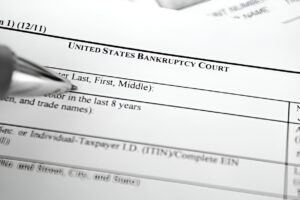How to Manage Bankruptcy Filing Costs in Texas

Filing for bankruptcy can be a lifeline when debt feels overwhelming, but the cost of filing can be an obstacle for many people. If you’re in Texas and wondering how to navigate the expenses associated with bankruptcy, this guide is for you. Let’s break down bankruptcy cost management in Texas, explore ways to make filing more affordable, and show you how Kisch Consumer Law can help you find relief without breaking the bank.
What Are the Costs of Filing for Bankruptcy in Texas?
Filing for bankruptcy involves several costs, and understanding them can help you plan effectively. Here’s what you can expect:
Filing Fees: Chapter 7 Bankruptcy: $338. Chapter 13 Bankruptcy: $313. These fees are standard and paid to the court when filing your case.
Credit Counseling and Debtor Education: Before filing, you’re required to complete a credit counseling session, which typically costs between $20 and $50. After filing, you must complete a debtor education course, usually priced similarly.
Attorney Fees: Attorney fees can vary widely depending on the complexity of your case. In Texas, Chapter 7 fees average between $1,000 and $1,500, while Chapter 13 fees can range from $2,500 to $4,000.
Additional Costs: You may need to pay for document copies, notary services, or court-mandated expenses related to your case.
How to Make Bankruptcy Filing More Affordable
Filing for bankruptcy doesn’t have to drain your wallet. Here are some tips to manage costs effectively:
Explore Fee Waivers and Payment Plans: For individuals with limited income, the court may waive filing fees or allow payment plans for the filing fee. Ask your attorney about eligibility requirements.
Work with an Affordable Attorney: Some law firms, like Kisch Consumer Law, specialize in making bankruptcy more accessible by offering flexible payment plans or sliding-scale fees based on your financial situation.
Utilize Free or Low-Cost Credit Counseling: Look for non-profit organizations approved by the U.S. Department of Justice for affordable credit counseling and debtor education. Many offer discounts or free services for low-income individuals.
Prioritize Chapter 13 for Long-Term Benefits: While Chapter 13 may seem more expensive upfront, it allows you to repay debts over time, potentially saving you money in the long run by avoiding wage garnishments or asset seizures.
What Are the Benefits of Affordable Bankruptcy Filing?
Investing in bankruptcy filing offers more than just immediate relief; it paves the way for long-term financial stability. Here’s what you gain:
Immediate Protection: Bankruptcy’s automatic stay halts creditor actions like wage garnishment, lawsuits, and repossession.
Debt Discharge: Depending on your chapter, eligible debts are wiped out or restructured, giving you breathing room to rebuild.
Asset Security: Texas laws include generous exemptions to protect your home, car, and other essentials.
Mental Relief: The cost of filing is far outweighed by the peace of mind it brings.
FAQs About Managing Bankruptcy Costs in Texas
Can I File for Bankruptcy Without an Attorney? While it’s legally possible to file without an attorney (called filing “pro se”), it’s risky. Mistakes can lead to case dismissal or loss of assets. Hiring an attorney ensures your case is handled correctly and your rights are protected.
Are There Free Legal Resources in Texas? Yes. Texas residents may qualify for free or low-cost legal aid through organizations like Legal Aid of NorthWest Texas or the Texas Legal Services Center.
Can Attorney Fees Be Paid in Installments? For Chapter 13 cases, attorney fees are often built into your repayment plan, allowing you to pay them over time. For Chapter 7 cases, many attorneys offer payment plans.
Do I Have to Pay All Fees Upfront? Not necessarily. Courts may allow fee installment plans, and some attorneys require partial payments upfront while filing.
How Kisch Consumer Law Makes Bankruptcy Affordable
At Kisch Consumer Law, we understand that financial hardship shouldn’t prevent you from accessing relief. Here’s how we help:
Free Initial Consultation: We assess your situation at no cost to you, so you can explore your options without financial pressure.
Flexible Payment Plans: We work with you to create a payment plan that fits your budget. Transparent Pricing: No hidden fees—just straightforward legal guidance tailored to your needs.
Experienced Advocacy: Our team specializes in Texas bankruptcy law, ensuring you get the best possible outcome.
Ready to take the next step? Contact Kisch Consumer Law today for a free consultation and discover how we can help you file for bankruptcy without breaking the bank.
How to Start the Bankruptcy Process in Texas
Starting your bankruptcy journey doesn’t have to be overwhelming. Here’s a step-by-step guide:
Consult with an Attorney: Speak to a trusted attorney to understand your options and costs.
Gather Financial Documents: Include income statements, debt records, and a list of assets.
Complete Credit Counseling: Enroll in an approved credit counseling course as required by law.
File Your Case: Submit your paperwork, pay the filing fee (or request a waiver), and let the process begin.
Bankruptcy Relief Without Breaking the Bank
Bankruptcy can feel daunting, but the financial relief it provides is worth the effort. By exploring affordable options, working with a trusted attorney, and taking advantage of payment plans and waivers, you can navigate the process without unnecessary stress. Imagine waking up tomorrow without creditors calling or worrying about wage garnishment. That future is possible, and it starts with taking the first step. Don’t let costs hold you back—visit Kisch Consumer Law today and let us guide you toward financial freedom. Because sometimes, starting over is the smartest move you can make.
